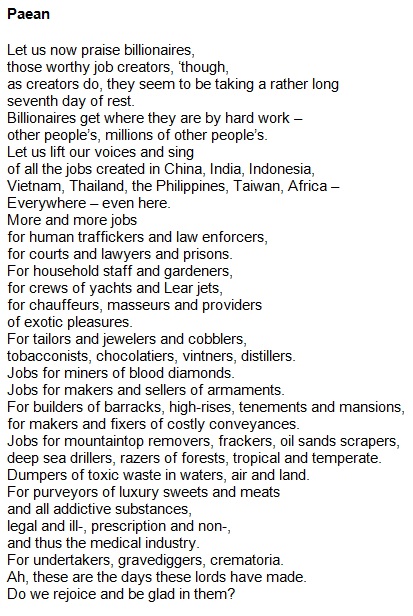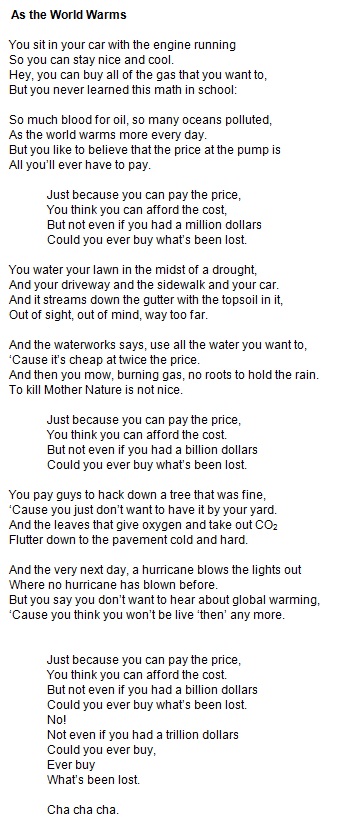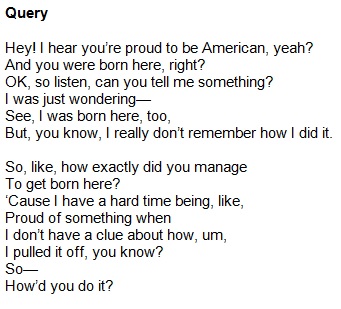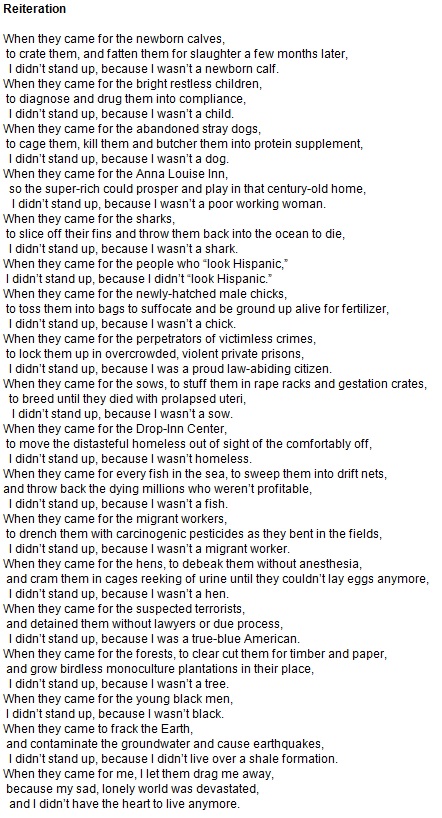I. Images For A Better World: Carole WINTERS, Visual Artist
Carole Winters, born in Northern Kentucky, spent most of her childhood in Western New York where her father, an electrical engineer, had relocated for work in the emerging television industry of the mid-50s. At age ten, a visit to a major exhibition of the work of Vincent Van Gogh inspired her to become an artist. The family moved back to Northern Kentucky after her father’s untimely death at age 38. During her high school years in the politically charged 60s, Winters worked on an underground newspaper and studied figure drawing at the Art Academy of Cincinnati. In 1973, she graduated with a degree in fine arts with a concentration in printmaking from Morehead State University in Eastern Kentucky.
After several art and non-art related jobs and an extended stay in Europe, Winters focused her attention on graphic design as an extension of her fine arts printmaking background. She worked at various printing companies learning production and design, eventually landing at F&W Publications as an art production manager, and later as Magazine Division Art Director, managing the design and production of The Artist’s Magazine, HOW Magazine, Writer’s Digest, among other titles.
Winters taught graphic design and design history at Northern Kentucky University after leaving F&W; she then returned to publishing as art director and associate publisher at ST Publications. She is now self-employed as a graphic designer and visual artist under the company name of Carole Winters Art + Design. She also serves as adjunct professor of art at Chatfield College in Over The Rhine.
Throughout her career in publishing, Winters continued to make visual art, exhibiting in several regional group and solo shows. Her work, often inspired by current events, explores political and social justice themes. She usually works in a narrative, illustrative style, incorporating borders and text, in a variety of dry and water-based media and printmaking. Recently she has been exploring book arts as a continuation of her experience in publishing.
In her drawings, paintings and mixed media works, Winters, has addressed the attacks of 9/11, the horrors of war, human rights and, specifically, women’s rights, universal healthcare, mental illness and homelessness. Below are some of her works that illustrate these concerns. She likes to quote Edward Abbey’s maxim “Society is like a stew. If you don’t stir it up every once in a while then a layer of scum floats to the top.”
Winters’ watercolor “The Butterfly Ballot,” which began as a commentary on the election debacle of 2000 (George Bush vs. Al Gore) and the infamous butterfly chad recount, soon ended up as a document about 9/11. When Winters once visited Texas Hill Country, she was fascinated by the unique flora and fauna of the area, including the many butterflies she encountered there. She pasted a newsprint photo of his head (Bush is from Texas) on the body of an Eastern Tiger Swallowtail. The strange insect dominates a smoggy urban landscape, a congested highway leads to a large city where two airplanes circle twin towers. Winters used her painting to point to ominous new realities that the world was quickly facing.
Visiting an antiques market, Winters discovered a group of old paper dolls. With their vacuous American 1950s “happy” expressions they provided her with good material to be used in stark contrast to the horrors of unnecessary wars in far-off places. They served as an inspiration for a series of her mixed media works relating to war.
In “Iraq I (Ordnance),” the paper dolls are represented missing various body parts, metaphors for victims of the first Iraq war, injured by Improvised Explosive Devices (IEDs) and land mines (ordnance). The girl paper dolls thus become symbolic of the innocent collaterals of warfare. Oil well fires burning in the distance, IEDs littering the landscape, and scattered dinosaur bones, all reference what she believes are the real reasons why recent wars are fought in the Middle East, i.e. the presence of oil.
On February 1, 2008, remote-controlled explosives strapped to two women with Down’s Syndrome were detonated in coordinated attacks on two Friday morning markets in central Baghdad. The first attack targeted shoppers at a pet market in the Al-Ghazl area, killing 46 people and injuring 100. 20 minutes later, a second bomber struck at a smaller bird market in southeastern Baghdad, killing 27 people and wounding at least 67. Reflecting on these events, Winters created “Iraq II (The Pet Market Bombing),” a mixed media piece which depicts two adult paper dolls wearing black niqabs (and clock bomb detonators) shown against the backdrop of a massive explosion in an urban landscape littered with blackened silhouettes of dead people and animals. A white dove symbolizing peace is seen flying away, escaping the explosion, above the spectral shapes of dinosaur bones, again referencing oil.
Even though many atrocities were committed during the invasion of Iraq after 9/11, for Winters this slaughter of the innocents was one of the most horrific. Unfortunately, such events fade away quickly from public memory; Winters wanted her work to remain as a constant reminder, to stand as witness, to the horrors of war and to disturbing memories that we would rather forget.
Afghanistan has been unsuccessfully occupied by foreign armies on and off for hundreds of years. Soldiers, sadly, are often the innocent victims, forced to navigate an ancient, mysterious culture and landscape. In August, 2011, in eastern Afghanistan, a Chinook helicopter was shot down by the Taliban, killing 31 U.S. Special Operation troops, most of them from the elite Navy SEALs unit that later killed al-Qaida leader Osama bin Laden. It was the deadliest single attack for American forces in the decade-long war, thankfully now concluded.
In her painting “Afghanistan (31 Soldiers Killed),” Winters represents Chinook helicopters hovering above the Afghan landscape showing a field of 31 opium poppies, a bloodied male soldier, and innocent “collateral damage” guardian girls. Her painting is meant to pay homage and respect to the fallen US troop heroes.
Throughout the 1980s, reports of torture and human rights violations made the news during a systematic campaign of terror against the rural Nicaraguan population by the Contras. Prompted by a vivid nightmare, the painting “Torture Nightmare” was Winters’ response to the civil unrest and revolution in Central America. Unfortunately, torture continues to dominate the headlines with the recent release of the Committee Study of the Central Intelligence Agency’s Detention and Interrogation Program about various forms of torture used on detainees between 2001 and 2006.
Winters created “She Spoke Her Mind” in response to her experience as a woman in the corporate workplace, specifically the magazine publishing industry where she worked for many years. The painting mimics the dimensions of a magazine spread with text and “illustration.” The hand-lettered text represents quotes, euphemisms, and actual comments made in meetings and on job reviews. Coming up against the Glass Ceiling, finding a balance between work and life, exercising choice, discovering assertiveness, and defining their role in the workplace continue to be issues women face today. Unfortunately, however, the need for income often muffles employees —women and men alike — and forces them to make compromises.
In “The Big Gamble,” huge, bold dice dominate a landscape strewn with people—ill, disabled, dead—at the mercy of fate, economics, and bad luck. Winters’ message through her drawing is that it doesn’t have to be this way, that life decisions should not be based on health insurance and that healthcare is a right, not a privilege, and surely not a gamble with one’s life.
Winters has long been interested in the plight of the mentally ill, having had custodianship of her elderly schizophrenic uncle for many years. She finds the mentally ill (and the homeless) often objectified in our society, not seen as real people with lives and families. In “Jack Warner” she wanted to document her uncle’s life and did so by combining his portrait with a list of his life events (active service in the Air Force, hospitalizations, arrests, near homelessness) and with vignettes from various times in his life. A lifelong smoker with a fondness for hardboiled eggs, her uncle is depicted on the banks of his beloved Ohio River in Dayton, Kentucky, his lifelong home. Winters employed a traditional grisaille technique to emphasize his limited life experience.
The painting “Wiffle Ball” was inspired by a young man living with mental illness in Winters’ childhood home of Oakfield, New York. He peacefully wandered the streets of the small village and had the good fortune to live with his mother. Rumor had it that he could explain in great detail the aerodynamics of a wiffle ball, which he holds in the painting, and that he was actually quite intelligent. The colorful, vibrating landscape is perhaps how he viewed his world, but his clouded mind remains impenetrable. Thanks to recent improvements in psychiatric drugs, Winters would like to hope that lives of individuals similar to her uncle and to this young wiffle ball man would be quite different today.
II. Words For A Better World: Mary-Jane NEWBORN, Literary Artist
When Mary-Jane Newborn was about nine years old she wrote the following verse: “The battle was raging with noise like thunder,/ The sight made poor Margaret cry,/ The battle was aging, castle walls torn asunder,/ Said Margaret, “Why must these men die?”.
When she was fourteen, she wrote a poem, “The Fallen Soldier,” which lamented the sorrowful futility of war; it was, however, regrettably lost when she abruptly left England in 1981. In Cincinnati, the projects SOS Art and For a Better World piqued her memory and she realized how early she was questioning the horror of violent conflicts, along with oppression and abuses of power, especially regarding children and flora and fauna. Destruction of the natural world has affected her deeply throughout her life.
At twelve years old, contemplating a world globe, Newborn saw that a bridge across the Bering Strait could empower one to walk from the tip of South America, up and through North America, across Asia, down Africa, up to Europe and to its far north. She was all excited, but also quickly disappointed when she realized that the US and the USSR were deadly enemies (it was 1959) and that this could not happen. She suddenly realized that almost all problems that humans encounter are caused by other humans.
Newborn now acknowledges that humanity currently faces the worst disaster it has ever wreaked, climate change, and that already millions of people and billions of other living beings are impacted by it, with no relief in sight. She believes that, if representatives of all species were to convene, humans would be voted off the planet.
Newborn writes poems and makes art to express her rage, terror and grief, sometimes obscurely, sometimes with humor. That, and activism, including extreme composting, maintaining a National Wildlife Federation Certified Wildlife Habitat, broad spectrum recycling, volunteering with VeganEarth, and providing a Little Free Library, enable her to face the everyday.
Her dream is to dwell in a vegan ecovillage adjoining protected wilderness, featuring permaculture food forests, organic gardens, a farmed animal sanctuary, studios, workshops, theaters and variegated enterprises dedicated to vibrant health, renewable energy and abundant simple living, compassionate toward all beings. She likes to imagine a world where all will live this way, and that it could be true.
1. Angrily inspired by the political pretensions of callous schemers, Newborn wrote “Paean” in early 2012. When she then entered it into the first annual adult poetry competition of the Public Library of Cincinnati and Hamilton County, she only hoped it would be read by the judges. When notified that it was one of four equal winners, she was really astonished. She had thought it too radical for Cincinnati; apparently it was not.
 2. Squatting by the gutter in summer 2007, using towels to retrieve one neighbor’s water, wring it into a bucket and dump it on her yard, Newborn observed a car at the other neighbor’s, idling in the heat. Dismayed by the heedless waste, she began singing to herself as consolation, and the first two verses and chorus of her poem “As the World Warms” emerged. A year later, the second neighbor had a mature hackberry tree–on Newborn’s property as she recently ascertained—chopped down. The third verse of the poem resulted.
2. Squatting by the gutter in summer 2007, using towels to retrieve one neighbor’s water, wring it into a bucket and dump it on her yard, Newborn observed a car at the other neighbor’s, idling in the heat. Dismayed by the heedless waste, she began singing to herself as consolation, and the first two verses and chorus of her poem “As the World Warms” emerged. A year later, the second neighbor had a mature hackberry tree–on Newborn’s property as she recently ascertained—chopped down. The third verse of the poem resulted.
In spring 2008 Newborn wrote “Denaturing”, torn between her desire to enjoy the preternatural green lushness and fear of being cited by the City for harboring “weeds.” That summer, she was cited. At a hearing, she pointed out the peach tree seedling, the sunflowers, the tomato plants and lambs’ quarters, and the inspector withdrew the citation. In 2011 the ordinance was amended, legalizing natural landscaping, through the valiant efforts of Deborah Jordan and a group of cited nature lovers. In October 2014 she was again cited and had another hearing. Thankfully, the citation was dismissed.
 4. Newborn sees her poem “Query” as a pretty self-explanatory response to “birthers” of various sorts who seem to want to stick their hands into the wombs.
4. Newborn sees her poem “Query” as a pretty self-explanatory response to “birthers” of various sorts who seem to want to stick their hands into the wombs.
5. In “Reiteration” Newborn pours out her frustration over the failure of humans to extend the circle of compassion to include all beings.
For most of her lifetime, including twelve years in England and seven in South Florida, Newborn has been a pedestrian. She wrote “Ambulatory” in 1987 in Miami Beach, where crossing the street was a life-threatening proposition. Unfortunately, such is also becoming the case in 2014 Cincinnati.
















